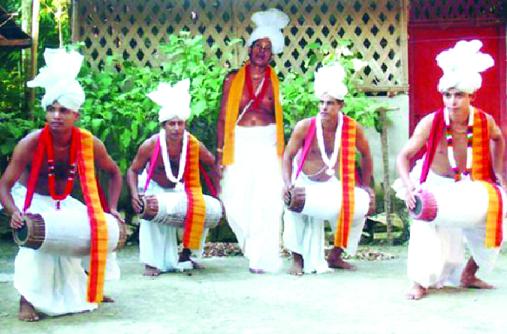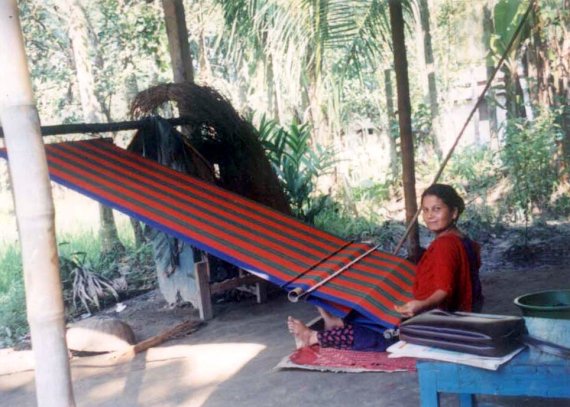Manipuri-মণিপুরী
মণিপুরী ভারত ও বাংলাদেশের একটি ক্ষুদ্র ও বৈশিষ্ট্যপূর্ণ জনগোষ্ঠীর নাম। এদের আদি নিবাস ভারতের মণিপুর রাজ্যে। মণিপুরীদের নিজস্ব ভাষা,বর্ণমালা, সাহিত্য এবং সমৃদ্ধ সংস্কৃতি রয়েছে। ভারতের মনিপুর রাজ্যে ও বাংলাদেশের সিলেট বিভাগের বিভিন্ন এলাকায় মণিপুরী সম্প্রদায়ের লোক বাস করে।

অষ্টাদশ শতাব্দীর শেষভাগ থেকে ঊনবিংশ শতাব্দীর প্রথমভাগ পর্যন্ত সংঘটিত বিভিন্ন সামাজিক, রাজনৈতিক ঘটনা প্রবাহের শিকার হয়ে এবং যুদ্ধজনিত কারণে ভারতের উত্তর-পূর্বাঞ্চলীয় মণিপুর রাজ্যের অধিবাসীরা দেশত্যাগ করে পাক-ভারত উপমহাদেশের বিভিন্ন অঞ্চলে আশ্রয় গ্রহণ করে। পার্শ্ববর্তী আসাম রাজ্যের কাছাড় জেলায়, ত্রিপুরা রাজ্যে এবং বাংলাদেশে ব্যাপক সংখ্যক মণিপুরী অভিবাসন ঘটে। বার্মা-মণিপুর যুদ্ধের সময় (১৮১৯-১৮২৫) তৎকালীন মণিপুরের রাজা চৌরজিৎ সিংহ, তার দুই ভাই মারজিৎ সিংহ ও গম্ভীর সিংহসহ সিলেটে আশ্রয়গ্রহণ করেন। যুদ্ধ শেষে আশ্রয়প্রার্থীদের অনেকেই স্বদেশে ফিরে যায়, কিন্তু বহু মণিপুরী তাদের নতুন স্থানে স্থায়ী বাসিন্দা হয়ে যায়। বাংলাদেশে আসা মণিপুরীরা ব্রাহ্মণবাড়িয়ার কসবা, ময়মনসিংহের দুর্গাপুর, ঢাকার মণিপুরী পাড়া এবং প্রধানত বৃহত্তর সিলেটের বিভিন্ন স্থানে বসতি গড়ে তোলে। বর্তমানে সিলেট বিভাগের মৌলভীবাজার, সিলেট, সুনামগঞ্জ, হবিগঞ্জ জেলায় মণিপুরী জনগোষ্ঠীর লোক বাস করে।
ভাষাগত এবং ধর্মীয় ভিন্নতার কারণে বাংলাদেশের মণিপুরীরা তিনটি শাখায় বিভক্ত এবং স্থানীয়ভাবে তারা (১) বিষ্ণুপ্রিয়া, (২) মৈতৈ ও (৩) পাঙন নামে পরিচিত। মণিপুরের অধিবাসীদের মধ্যে এই তিনটি সংখ্যাগরিষ্ঠ সম্প্রদায় রাজনৈতিক ঘটনাপ্রবাহের শিকার হয় এবং তারা বাংলাদেশে এসে পাশাপাশি বসতি স্থাপন করে। বিষ্ণুপ্রিয়ারা ককেশয়েড মহাজাতির আর্য-ভারতীয় উপপরিবারের অন্তর্গত এবং তাদের ভাষার নাম বিষ্ণুপ্রিয়া মনিপুরি ভাষা। মৈতৈরা মঙ্গোলয়েড মহাজাতির তিব্বতী-বর্মী উপ-পরিবারের অন্তর্গত এবং তাদের ভাষার নাম মৈ তৈ। পাঙনরা আর্য বংশদ্ভুত হলেও মৈতৈ ভাষায় কথা বলে এবং ধর্মীয়ভাবে তারা মুসলিম। বাংলাদেশের মণিপুরীদের মধ্যে বিষ্ণুপ্রিয়ারা সংখ্যাগরিষ্ঠ। পরিসংখ্যান অনুযায়ী ২০০৩ সাল নাগাদ বাংলাদেশে মণিপুরী বিষ্ণুপ্রিয়া জনসংখ্যা ৪০ হাজার এবং মণিপুরী মৈতৈ জনসংখ্যা ১৫ হাজার। ভাষাগত ভিন্নতা বাদ দিলে বিষ্ণুপ্রিয়া ও মৈতৈদের মধ্যে সামাজিক, সাংস্কৃতিক ও ধর্মীয় ক্ষেত্রে তেমন পার্থক্য নেই।

মণিপুরীদের সংস্কৃতি অত্যন্ত সমৃদ্ধ ও ঐতিহ্যবাহী। মণিপুরী সংস্কৃতির উজ্জ্বলতম দিক হলো মণিপুরী নৃত্য যা বিশ্বব্যাপী সমাদৃত। মণিপুরীদের মধ্যে ঋতুভিত্তিক আচার অনুষ্ঠান বেশি। বছরের শুরুতে হয় মণিপুরী বিষ্ণুপ্রিয়াদের বিষু এবং মৈতৈদের চৈরাউবা উৎসব। আষাঢ় মাসে জগন্নাথদেবের রথযাত্রা ও কাঙ উৎসবের সময় প্রতিরাত্রে মণিপুরী উপাসনালয় ও মন্ডপগুলোতে বৈষ্ণব কবি জয়দেবের গীতগোবিন্দ নাচ ও গানের তালে পরিবেশন করা হয়। কার্ত্তিক মাসে মাসব্যাপী চলে ধর্মীয় নানান গ্রন্থের পঠন-শ্রবন। এরপর আসে মণিপুরীদের বৃহত্ম উৎসব রাসপূর্ণিমা। অষ্টাদশ শতাব্দীতে মণিপুরের রাজা মহারাজ ভাগ্যচন্দ্র প্রবর্তিত শ্রীকৃষ্ণের রাসলীলানুকরন বা রাসপুর্ণিমা নামের মণিপুরীদের সর্ববৃহৎ অনুষ্ঠানটি বাংলাদেশে প্রায় দেড়শত বছর ধরে (আনুমানিক ১৮৪৩ খ্রী: থেকে) পালিত হয়ে আসছে। কার্ত্তিকের পুর্ণিমা তিথিতে দুরদুরান্তের ল ল ভক্ত-দর্শক মৌলবীবাজার জেলার সিলেটের কমলগঞ্জের মাধবপুর জোড়ামন্ডবের এই বিশাল ও বর্ণাঢ্য উৎসবের আকর্ষনে ছুটে আসেন। বসন্তে দোলপূর্ণিমায় মণিপুরীরা আবির উৎসবে মেতে উঠে। এসময় পালাকীর্ত্তনের জনপ্রিয় ধারা “হোলি” পরিবেশনের মাধ্যমে মণিপুরী তরুণ তরুণীরা ঘরে ঘরে ভিক্ষা সংগ্রহ করে। এছাড়া খরার সময় বৃষ্টি কামনা করে মণিপুরী বিষ্ণুপ্রিয়ারা তাদের ঐতিহ্যবাহী বৃষ্টি ডাকার গান পরিবেশন করে থাকে।
মণিপুরীদের নিজস্ব লৌকিক ধর্মের নাম “আপোকপা” যা অত্যন্ত প্রাচীন, আধ্যাত্মিকতায় গভীর ও দার্শনিকভাবে উচ্চস্তরের। প্রাচীন ধর্মবিশ্বাস অনুযায়ী সৃষ্টিকর্তা নিজের প্রতিকৃতি থেকে মানব জাতিকে সৃষ্টি করেছেন এবং প্রতিটি মানুষ সৃষ্টিকর্তার একেকটি ছায়া। এখনো মণিপুরী মৈতৈদের অনেকে এই ধর্মের অনুসারী। মণিপুরী বিষ্ণুপ্রিয়াদের একাংশের মধ্যের “আপোকপা” পূজার প্রচলন রয়েছে। অষ্টাদশ শতাব্দীতে মণিপুরীরা বৈষ্ণব ধর্মে দীক্ষিত হয়।
মণিপুরী জনগোষ্ঠীর প্রধান দুই জনগোষ্ঠীর মধ্যে ভাষার পার্থক্য রয়েছে, যেমন –
মণিপুরী মৈতৈ ভাষাকে তিব্বতি-বর্মী উপ-পরিবারের কুকি-চিন দলে এবং বিষ্ণুপ্রিয়া ভাষাকে ইন্দো-আর্য উপ-পরিবারের বাংলা-অসমীয়া দলে অন্তর্ভুক্ত করা হয়, যদিও এই শ্রেণীকরণ নিয়ে ভাষাতাত্ত্বিকদের মধ্যে যথেষ্ট মতভেদ রয়েছে। অনেকে বিষ্ণুপ্রিয়া ভাষাকে মহারাষ্ট্রী-সৌরসেনী ভাষাশ্রেণীর আবার কেউ কেউ একে ইন্দো-মঙ্গোলয়েড উপশ্রেণীর তালিকাভুক্ত করা সমিচীন মনে করেন। উৎস ও বিকাশের ক্ষেত্রভুমি অভিন্ন হওয়ায় উভয় ভাষার মধ্যে ব্যাকরণগত সামঞ্জস্য রয়েছে। উভয় ভাষাতেই পার্বত্য নাগা ও কুকিভাষার প্রভাব পরিলতি হয়। শব্দভাণ্ডারের দিক থেকে উভয় ভাষাতেই ব্যবহৃত হয় এমন শব্দসংখ্যা চার হাজারেরও বেশি।
১৮৮৯ সনে প্রকাশিত ভারতবর্ষের ভাষা শ্রেণীবিভাগের প্রধান ভিত্তি স্যার জর্জ আব্রাহাম গ্রিয়ার্সনের Linguistic Survey of India-তে মৈতৈ ভাষার পাশাপাশি বিষ্ণুপ্রিয়া মণিপুরী ভাষাকে মণিপুরের অন্যতম ভাষা হিসাবে উল্লেখ করা হয়েছে। দুইটি ভাষাই ভারতে স্বীকৃতি লাভ করেছে এবং আসাম ও ত্রিপুরা রাজ্যের স্কুলগুলোতে মণিপুরী মৈতৈ ও বিষ্ণুপ্রিয়া উভয় ভাষায় শিক্ষা গ্রহণের সুযোগ করে দিয়েছে। মণিপুরি (মৈতৈ) ভাষা ভারতের অন্যতম রাস্ট্রভাষা এবং মণিপুর রাজ্যের রাজ্যভাষা। মণিপুর রাজ্যে মণিপুরী মৈতৈ ভাষায় স্নাতকোত্তর পর্যায় পর্যন্ত শিক্ষাগ্রহণের সুযোগ রয়েছে। তবে বিষ্ণুপ্রিয়া ভাষায় মণিপুরে শিক্ষাগ্রহণের সুযোগ নেই। ১৯৭৬ সাল থেকে বাংলাদেশ বেতার সিলেট কেন্দ্র থেকে প্রতি সপ্তাহে “মণিপুরী অনুষ্ঠান” শিরোনামে পর্যায়ক্রমে বিষ্ণুপ্রিয়া ও মৈতৈ ভাষায় অনুষ্ঠান প্রচার শুরু হয় এবং এই অনুষ্ঠানের সম্প্রচার এখনো অব্যাহত রয়েছে।

সূর্যদেবতার উদ্দেশ্যে রচিত গীতিকবিতা ঔগ্রী মণিপুরী মৈতৈ সাহিত্যের প্রাচীনতম নিদর্শন, যা খ্রীস্টিয় ৩৩ অব্দে রচিত। ঐছাড়া অনেক প্রেমগীতি ও লোকগাথা মণিপুরী মৈতৈ সাহিত্যের অমূল্য সম্পদ। মণিপুরি (মৈতৈ) সাহিত্যের লিখিত অস্তিত্ব পাওয়া যায় খ্রিষ্টীয় অষ্টম শতাব্দী থেকে। অপরদিকে বিষ্ণুপ্রিয়া মণিপুরী ভাষারও প্রাচীন সাহিত্যেভাণ্ডার রয়েছে। বরন ডাহানির এলা (বৃষ্টি ডাকার গান / ১৪৫০-১৫০০ খ্রী:), মাদই সরাহাল এলা (বিষ্ণুপ্রিয়া মণিপুরী লোকগান / ১৬০০-১৭০০ খ্রী:),খাম্বাথৈবীর প্রেমকাহিনী(১৫০০-১৬০০ খ্রী:), আপাঙর য়্যারী (লোককথা), পৌরেই (প্রবচন) ইত্যদি বিষ্ণুপ্রিয়া মণিপুরী লোকসাহিত্যর অমূল্য সম্পদ। উনিশ শতকের মধ্যভাগে তৎকালীন বৃটিশ ভারতের রাজনৈতিক এজেন্ট Colonel McCullock তাঁর Valley of Manipur and Hill Tribes গ্রন্থে ইংরেজি, মণিপুরী বিষ্ণুপ্রিয়া ও মণিপুরী মৈতৈ ভাষার তুলনামুলক সংক্ষিপ্ত অভিধান প্রণয়ন করেন।
হাতে বোনা কাপড় তৈরীতে মণিপুরীরা খুবই দক্ষ। নিজেদের কাপড় তারা নিজেরাই তৈরি করে থাকে। প্রায় প্রতিটি ঘরেই তাঁত রয়েছে। মণিপুরী হস্তশিল্প বিশ্বময় সমাদৃত। মণিপুরীদের বোনা তাঁতের শাড়ি, গামছা, চাদর,ব্যাগ ইত্যাদি অন্যান্য জাতির মধ্যেও সমান জনপ্রিয়।
বৃটিশ শাসনামলে মণিপুরী কৃষকদের সংগ্রামের ইতিহাস সর্বজনবিদিত। ১৯৪৩ সনে জমিদারী ও সামন্তবাদের বিরুদ্ধে বিদ্রোহ ঘোষণা করেছিল তৎকালীন মৌলবীবাজার মহকুমার ভানুগাছ পরগনার ভানুবিল গ্রামের মণিপুরী বিষ্ণুপ্রিয়া ও মণিপুরী মৈতৈ স¤প্রদায়ের কৃষকরা।
The Manipuris are one of the major ethnic communities of Bangladesh. They migrated to Bangladesh during the reign of Rajarshi Bhagyachandra (1764-1789) and the process was accelerated by the Manipuri-Burma war. After the war with Burma, Manipur was ruled by the Burmese invaders for about seven years. During that period, King Chourajit Singh accompanied by a large following of Manipuri subjects moved to areas - now in Bangladesh. At present they live in different places of Sylhet Division, like Kamalganj, Sreemongal, Kulaura and Baralekha thanas of Moulvi Bazar district; Chunarughat thana of Habiganj district and Chhatak thana of Sunamganj district. According to the 1991 population census, there were about 25,000 Manipuris in Bangladesh. As a result of their changing geographical locations and various kinds of religious and political interaction, Manipuri society became the meeting point of different ethnic groups and cultures. The mother-tongue of the Manipuris belongs to the Kuki-chin group of the Tibeto-Burman sub-family of the Mongolian family of languages. Manipuri literature is very old. It has a rich and variegated history and traditions. Interestingly, a characteristic of the old Manipuri script is that each and every letter of the alphabet has been named after a part of the human body. The shape of a letter is also based on the body part it is named after. Some books on Manipuri subjects have been published in Bengali. Manipuri men and women work together in the field. Men clear the jungles and till the soil, while the women sow seeds and do the transplanting. They celebrate seed planting and crop harvesting in their own colourful way. Manipuri culture has a rich and colourful tradition where dance and music play a vital role. The most vibrant branch of Manipuri culture is dance. Rasa dance is the finest product of their culture. Manipuri dance is characterized by gentleness, tenderness and devotion. The dress they wear during a dance is really gorgeous and beautiful. Most of the festivals of the Manipuris are accompanied by the consumption of alcoholic beverages.A very popular festival of the Manipuris is a type of Gopi dance celebrating the romantic liaison of Radha and Krishna. In the spring, Manipuris celebrate Holi, when they drench each other with colour. Most religious rites and festivals of the Manipuris are based on the seasons of the year. They also celebrate the rice harvest through a singing contest. Manipuris put up colourful wedding pandals, and the bride and groom go round the pandal to be greeted with paddy and durva grass. Manipuris cannot marry within their own clans. A Manipuri bride comes to visit her parents for the first time on the fifth day after marriage, providing an occasion for a lavish feast. According to tribal custom, all members of the clan are invited to this ceremony and they come with presents of rice, meat, fowls, pigs, money and alcohol. Manipuris have their own rituals regarding disposal of the dead body. They keep the dying person outside the house on a banana leaf, while Kirtans are chanted. Dead bodies are washed with the head pointed northward. They bury bodies of adolescents and cremate bodies of older persons. After disposing of the body, the pallbearers take a bath and dry their hands by holding them above a fire before entering their house.


